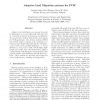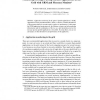HIPEAC
2011
Springer
13 years 5 months ago
2011
Springer
Much compiler-orientated work in the area of mapping parallel programs to parallel architectures has ignored the issue of external workload. Given that the majority of platforms w...
ICPADS
2010
IEEE
14 years 4 months ago
2010
IEEE
Abstract-Predicting sequential execution blocks of a large scale parallel application is an essential part of accurate prediction of the overall performance of the application. Whe...
SOSP
1989
ACM
14 years 7 months ago
1989
ACM
Shared-memory multiprocessors are frequently used in a timesharing style with multiple parallel applications executing at the same time. In such an environment, where the machine ...
PDPTA
2000
14 years 7 months ago
2000
Internet-based clusters of workstations have been extensively used to execute parallel applications. Although these internet-based clusters seem to be an easy and inexpensive way ...
CCGRID
2001
IEEE
14 years 9 months ago
2001
IEEE
High performance computing on parallel architectures currently uses different approaches depending on the hardory model of the architecture, the abstraction level of the programmi...
SC
1994
ACM
14 years 10 months ago
1994
ACM
Adaptive load distribution is necessary for parallel applications to co-exist e ectively with other jobs in a network of shared, heterogeneous workstations. We present three metho...
ICDCS
1997
IEEE
14 years 10 months ago
1997
IEEE
Clusters of workstations are increasingly being viewed as a cost-e ective alternative to parallel supercomputers. However, resource management and scheduling on workstations clust...
CF
2010
ACM
14 years 11 months ago
2010
ACM
Supercomputers need a huge budget to be built and maintained. To maximize the usage of their resources, application developers spend time to optimize the code of the parallel appl...
ICCS
2004
Springer
14 years 11 months ago
2004
Springer
Abstract. A new approach for acquiring knowledge of parallel applications regarding resource usage and for searching similarity on workload traces is presented. The main goal is to...
EAGC
2004
Springer
14 years 11 months ago
2004
Springer
Application monitoring in the grid for parallel applications is hardly supported in recent grid infrastructures. There is a need to visualize the behavior of the program during its...


